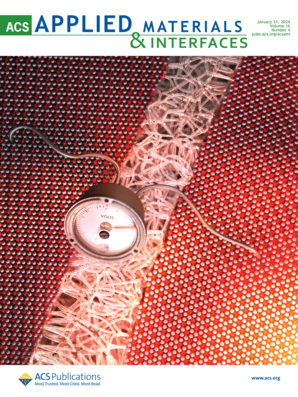Electrochemical Liquid-Liquid-Solid Electrodeposition of Ge Nanowire Films with Low Reflectance for Light Management Coatings and High Mass-Loading for High Areal Capacity Li+ Battery Anodes.
IF 8.3
2区 材料科学
Q1 MATERIALS SCIENCE, MULTIDISCIPLINARY
引用次数: 0
Abstract
A simple method for the electrodeposition of dense semiconductor nanowire films on metal foils via the electrochemical liquid-liquid-solid (ec-LLS) method has been demonstrated. Thin liquid InBiCd coatings on metal foil electrodes were used to seed the Ge nanowire growth in an aqueous electrolyte. The resultant Ge nanowire films were characterized via scanning electron microscopy, X-ray diffraction, angle-resolved reflectance spectra, and cyclic voltammetry both outside and within a coin cell by using a Li counter electrode. High magnification electron microscopy indicated that the nanowire sizes and densities depended on the nature of the underlying metal foil. The highest density and thinnest nanowires were obtained with the Cu foil substrates. The as-deposited Ge nanowires were highly crystalline and exhibited a coiled microstructure. The mass density of the films linearly tracked with a longer electrodeposition time. At the highest mass loadings, the films were visibly dull black and exhibited a wavelength-independent total reflectance of ∼10% across visible and near-infrared wavelengths. Separate specular reflectance measurements confirmed that the total reflectance was dominated by diffuse scattering. Optical simulation corroborated the premise that a high density of randomly oriented Ge nanowires with large-angle orientations significantly reduces the total reflectance of such films. Voltammetric measurements indicated that Li+ insertion took place predominantly in the Ge nanowires, with a high initial areal (gravimetric) discharge capacity of 4.12 mA h cm-2 (1359 mA h g-1). An areal (gravimetric) capacity of 2.10 mA h cm-2 (691 mA h g-1) was retained after 50 cycles while maintaining 98.7% Coulombic efficiency. This work significantly advances the use of ec-LLS as a synthesis approach for functional nanowire film for a high-mass loading anode for Li-ion batteries and low reflectance coatings.用于高面积容量锂电池阳极的低反射率、高质量负载的锗纳米线薄膜的电化学液-液-固电沉积。
提出了一种在金属箔上电沉积致密半导体纳米线薄膜的简单方法——电化学液-液-固方法。在金属箔电极上涂上薄的液态铟镉涂层,在水电解质中播种锗纳米线的生长。通过扫描电子显微镜、x射线衍射、角度分辨反射光谱和循环伏安法,利用锂对电极对硬币电池内外的锗纳米线薄膜进行了表征。高倍电子显微镜显示,纳米线的尺寸和密度取决于下面金属箔的性质。在铜箔衬底上得到了密度最高、最细的纳米线。沉积的锗纳米线高度结晶,呈盘绕状微观结构。薄膜的质量密度随电沉积时间的延长呈线性变化。在最高质量负载下,薄膜呈现明显的暗黑色,并且在可见光和近红外波长上表现出波长无关的总反射率约为10%。单独的镜面反射率测量证实了全反射率主要是漫射散射。光学模拟证实了高密度、大角度取向的随机取向锗纳米线可以显著降低薄膜的总反射率。伏安测量表明,Li+的插入主要发生在Ge纳米线中,具有较高的初始面积(重量)放电容量,为4.12 mA h cm-2 (1359 mA h g-1)。循环50次后,面积(重量)容量为2.10 mA h cm-2 (691 mA h g-1),库仑效率保持在98.7%。这项工作大大推进了ec-LLS作为锂离子电池高质量负载阳极和低反射涂层的功能纳米线膜的合成方法。
本文章由计算机程序翻译,如有差异,请以英文原文为准。
求助全文
约1分钟内获得全文
求助全文
来源期刊

ACS Applied Materials & Interfaces
工程技术-材料科学:综合
CiteScore
16.00
自引率
6.30%
发文量
4978
审稿时长
1.8 months
期刊介绍:
ACS Applied Materials & Interfaces is a leading interdisciplinary journal that brings together chemists, engineers, physicists, and biologists to explore the development and utilization of newly-discovered materials and interfacial processes for specific applications. Our journal has experienced remarkable growth since its establishment in 2009, both in terms of the number of articles published and the impact of the research showcased. We are proud to foster a truly global community, with the majority of published articles originating from outside the United States, reflecting the rapid growth of applied research worldwide.
 求助内容:
求助内容: 应助结果提醒方式:
应助结果提醒方式:


